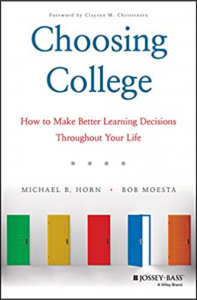For years, college-for-all was the dominant narrative of pundits, parents, and high school guidance counselors. And most people interpreted that directive to mean that everyone should attend a four-year university.
That’s starting to change. I hear more every day about apprenticeships, community colleges, certificate programs, and coding academies. But students still need guidance when making crucial decisions about what they will learn and how they will enter the labor market.
That’s where a new book by Michael B. Horn and Bob Moesta comes in. Choosing College: How to Make Better Learning Decisions Throughout Your Life, published last fall, provides a new framework for thinking about postsecondary education options. As the authors say in the introduction, they want potential students to ask a foundational question about education: Why?
Why are you seeking more education in your life? Or why should you? What is the progress you are trying to make?
When asked, students usually answer that they’re going to college “to get a job.” New America Foundation’s 2015 College Decisions Survey questioned 1,011 U.S. residents ages 16-40 who were either prospective college students or enrolled in their first semester of college. New America reported:
[T]he top reasons to decide to go to college among the reasons listed in the survey are: 1) To improve employment opportunities (91 percent); 2) To make more money (90 percent); and 3) To get a good job (89 percent). In fact, 7 out of 10 students describe each of these items as very important.
But students (and potential students) don’t always make decisions that comport with their stated preferences. Many students choose colleges and universities with bad track records in terms of graduate employment. And others end up underemployed because they chose majors with low demand.
Horn and Moesta say that one reason for the disconnect is that students’ reasons for choosing a college are actually “more complicated” than just improving their employment opportunities. Unlike many college boosters, they also realize that for many people, college doesn’t work and for other people, college ends up not paying off. That understanding helps the authors give more realistic advice.

Horn and Moesta offer their own survey of more than 1,000 students as well as 200 detailed stories of individuals making college choices. The bulk of the book, entitled “Helping Learners Make Better Choices,” is devoted to such individuals. It starts with a section about getting into the “best school for you” and ends with “Five Principles for Your Learning Journey,” the most important of which is “Your Learning Journey Will Last A Lifetime.” The personal stories and advice are tailored for students and parents trying to make better education decisions.
The book’s most important insight comes from Bob Moesta’s Jobs to Be Done theory, which was created in conjunction with the late Clayton Christensen more than 20 years ago. Christensen described the theory in his foreword to the book: “In a nutshell, people don’t buy products or services because they fall into a particular demographic category. Rather people hire services to get a job done in their lives so they can make progress.” Those “services” include education.
In the context of this book, the theory explains that people choose a school with five things (or “jobs”) in mind:
- Getting into “their best” school
- Doing what’s expected of them
- Getting away
- Stepping it up
- Extending themselves
The authors explain that knowing which “job” students want their college experience to do can help them figure out what success looks like.
For education reformers, the last section of the book is most relevant: “Helping Educators Design for Better Choices.” In particular, it encourages education providers to think about the “job” students want to accomplish instead of just assuming they know what students need. Once universities discover what students are trying to get done, they can tailor what they’re doing to fit those “jobs.”
That’s not an easy task. Students who want to do different jobs often need “fundamentally different experiences to be successful and satisfied,” said Horn and Moesta. Students who want to step it up care about “convenience, customer service, speedy completion times, and credentials.” But students who want to get into their best school are often focused on the university experience such as “sports teams, climbing walls, and interaction with faculty around the meaning of life.” A university that tries to deliver on both of these “jobs” at the same time and in the same way will often fail at both.
They suggest that universities’ organizational structures should be among the first things that change since they aren’t focused on students’ “jobs” at all. Instead, universities are organized the way they are—in academic departments—in order to do a “job” that professors want to do: publish and get tenure. They’re not organized in ways to “optimize the flow of students through the requisite experiences.”
The book provides several examples, including Southern New Hampshire University and a new school called Wayfinding Academy in Portland, Oregon to illustrate what applying the Jobs to Be Done theory institutionally looks like in action.
Both students and university leaders have a lot to learn from this book. Asking “why” is the first step.
Jenna A. Robinson is president of the James G. Martin Center for Academic Renewal.
